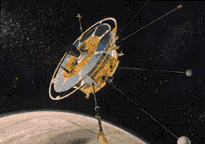Freja
 Freja is designed to image the aurora and measure particles and fields in the upper ionosphere and lower magnetosphere. The mission continues the investigations begun by its predecessor Viking. Freja was initiated in 1987 when a low-cost launch reservation on a Long March rocket for a small store-and-forward low-orbit communications satellite was cancelled. The total cost of the program through 2 years of operations, excluding instruments, was $19 million. The project was jointly financed by Sweden and the Federal Republic of Germany.
Freja is designed to image the aurora and measure particles and fields in the upper ionosphere and lower magnetosphere. The mission continues the investigations begun by its predecessor Viking. Freja was initiated in 1987 when a low-cost launch reservation on a Long March rocket for a small store-and-forward low-orbit communications satellite was cancelled. The total cost of the program through 2 years of operations, excluding instruments, was $19 million. The project was jointly financed by Sweden and the Federal Republic of Germany.
Spacecraft
Magnesium structure. 3-axis magnetometer, sun sensors, IR earth sensor provide 0.5 deg. attitude knowledge. Spin stabilized, sun-pointing attitude maintained by magnetorquers. Annular solar arrays provide 130W, NiCd batteries. 2W S-band transmitter downlinks at 256 kbps to 9 m dish. UHF uplink. The satellite was a protoflight development effort.
Payload
Payload mass 60 kg, uses 81 W. Six radial wire booms (1-15 m) and two stiff radial booms (1-2 m) used by experiments. Experiments include F1 - Electric Fields (Royal Inst. of Technology, Sweden); F2 - Magnetic Fields (APL/JHU); F3C - Cold Plasma (NRC, Canada); F3H - Hot Plasma
(Swedish Inst. of Space Physics; F4 - Waves (Swedish Inst. of Space Physics; F5 - Auroral Imager (Univ. of Calgary); F6 - Electron Beam (Max-Planck Inst.); F7 - Particle Correlator (Max-Planck Inst.)
| Country of Origin | Sweden |
| Customer/User | Swedish Space Corporation (SSC) |
| Manufacturer(s) | Swedish Space Corporation (SSC) |
| Size | 2.2 m diameter disk, 1.7 m high |
| Orbit | 601 x 1756 km, 63 deg inclination |
| Design Life | 2 years |
Launch Facts
| Name | Int'l Desig. | Date | Site | Vehicle | Orbit | Mass(kg) |
| Notes | ||||||
| Freja | 1992-064A | 10/6/92 | Shuang Cheng Tzu | CZ-2C | LEO | 259 |
| Ionospheric, auroral, amgnetospheric studies | ||||||
Information in The Mission and Spacecraft Library is provided without warranty or guarantee. USE AT YOUR OWN RISK.